ignition CHEVROLET TRACKER 1993 Owner's Manual
[x] Cancel search | Manufacturer: CHEVROLET, Model Year: 1993, Model line: TRACKER, Model: CHEVROLET TRACKER 1993Pages: 339, PDF Size: 15.75 MB
Page 158 of 339
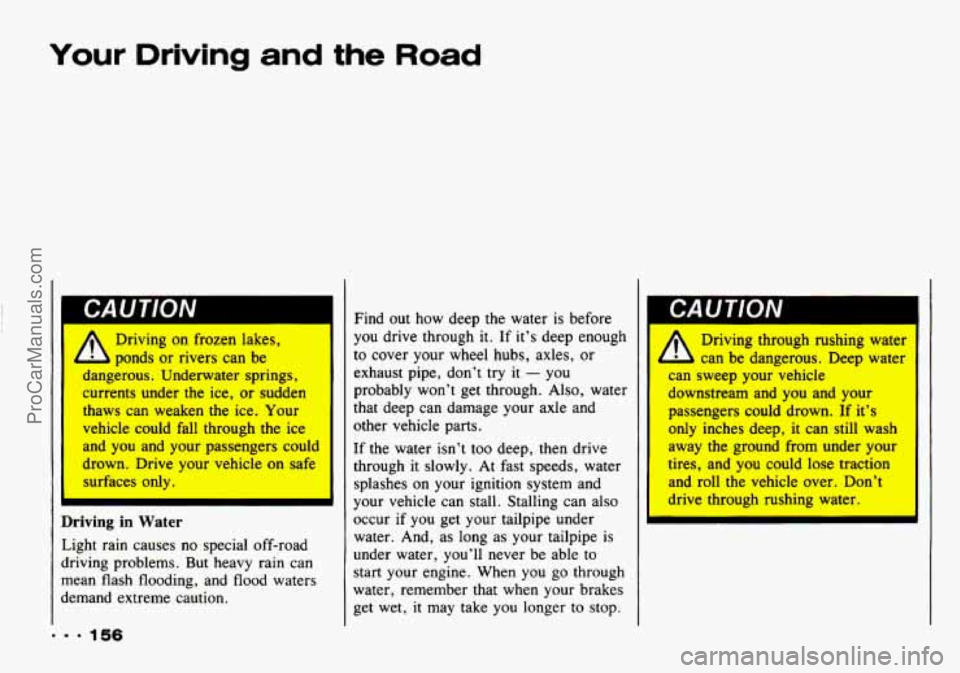
Your Driving and the Road
I CAUTION
A
Driving on frozen lakes,
ponds or rivers can be
dangerous. Underwater springs,
currents under the ice, or sudden
thaws can weaken
the ice. Your
vehicle could fall through
the ice
and you and your passengers could
drown. Drive your vehicle
on safe
surfaces only.
I CAUTION
)riving in Water
ight rain causes no special off-road
riving problems. But heavy rain can
lean flash flooding, and flood waters
emand extreme caution. Find
out how deep the water is before
you drive through it. If it’s deep enough
to cover your wheel hubs, axles, or
exhaust pipe, don’t
try it - you
probably won’t get through.
Also, water
that deep can damage your axle and
other vehicle parts.
If the water isn’t too deep, then drive
through it slowly. At fast speeds, water
splashes on your ignition system and
your vehicle can stall. Stalling can also
occur
if you get your tailpipe under
water. And, as long as your tailpipe is
under water, you’ll never be able to
start your engine. When you go through
water, remember that when your brakes
get wet,
it may take you longer to stop.
’ Driving through rushing water
- can be dangerous. Deep water
-m sweep your vehicle
downstream and you and your
passengers could drown. If it’s
only inches deep, it can still wash
away the ground from under your
tires, and you could lose traction
and roll the vehicle over. Don’t
drive through rushing water.
... 156
ProCarManuals.com
Page 172 of 339

Your Driving and the Road
Know how to go down hills. The
most important thing to know is this:
let your engine do some
of the
slowing down. Don’t make your
brakes do it all. Shift to a lower gear
when you
go down a steep or long
hill. That way,
you will slow down
without excessive use
of your brakes.
CA UT/ON
A
If you don’t shift down, your
brakes could get
so hot that
they wouldn’t work well.
You
would then have poor braking or
even none going down a hill. You
could crash. Shift down
to let your
engine assist your brakes on a steep downhill slope.
A Coasting downhill in N
r - a (Neutral) or with the ignition
off is dangerous. Your brakes will
have to do all the work
of slowing
down. They could get
so hot that
they wouldn’t work well. You
could crash. Always have your
engine running and your vehicle in
gear when you
go downhill.
... 170
ProCarManuals.com
Page 188 of 339
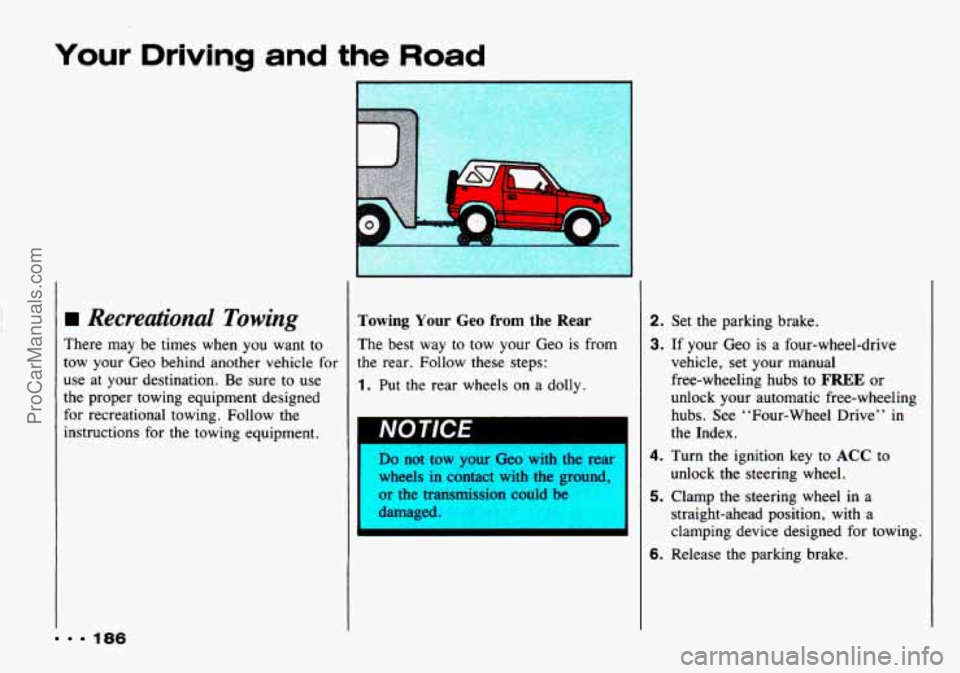
Your Driving and the Road
Recreational Towing
There may be times when you want to
tow your Geo behind another vehicle for
use at your destination. Be sure to use
the proper towing equipment designed
for recreational towing. Follow
the
instructions for the towing equipment.
186
Towing Your Geo from the Rear
The best way to tow your Geo is from
the rear. Follow these steps:
1 . Put the rear wheels on a dolly.
NOTlCE
Do not tow your Geo with the re--
wheels in contact with the grounL,
or
the transmission could be
damaged.
2. Set the parking brake.
3. If your Geo is a four-wheel-drive
vehicle, set your manual
free-wheeling hubs to
FREE or
unlock your automatic free-wheeling
hubs. See “Four-Wheel Drive’’
in
the Index.
4. Turn the ignition key to ACC to
unlock the steering wheel.
5. Clamp the steering wheel in a
straight-ahead position,
with a
clamping device designed for towing.
6. Release the parking brake.
ProCarManuals.com
Page 189 of 339
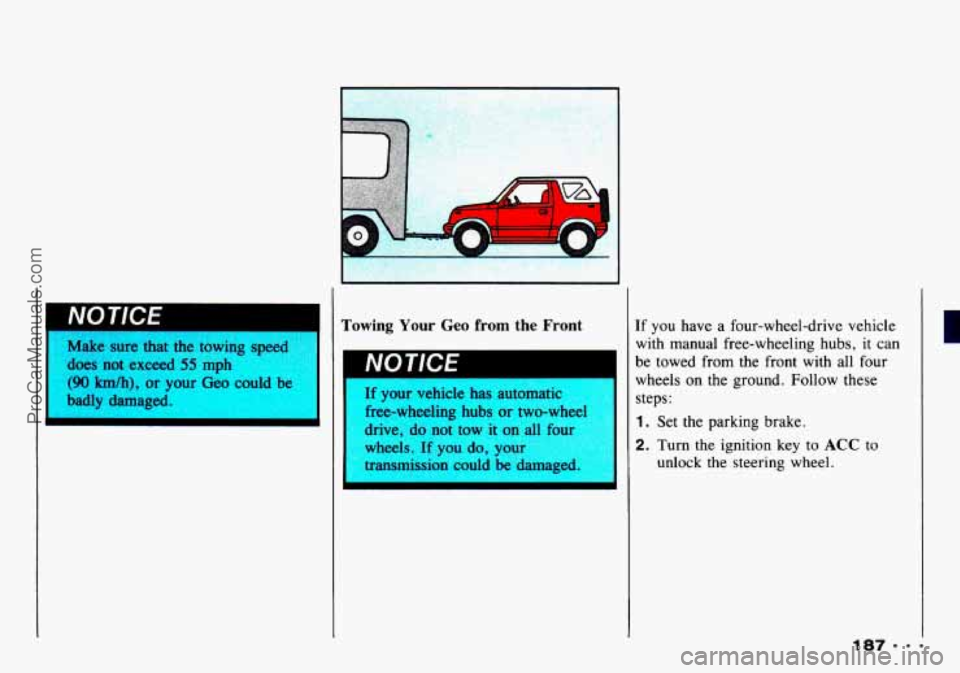
Make sure that the towing speed
dues not exceed 55 mph
(90 km/h), or your Geo could be
badly damaged.
Towing Your Geo from the Front
If your vehicle has automatic
I free-wheeling hubs or two-whet
drive, do not tow it
on all fa
I wheels. If you do, you transmission could be damaged.
I
If you have a four-wheel-drive vehicle
with manual free-wheeling hubs, it can
be towed from the front with all four
wheels on the ground. Follow these
steps:
1. Set the parking brake.
2. Turn the ignition key to ACC to
unlock the steering wheel.
ProCarManuals.com
Page 190 of 339
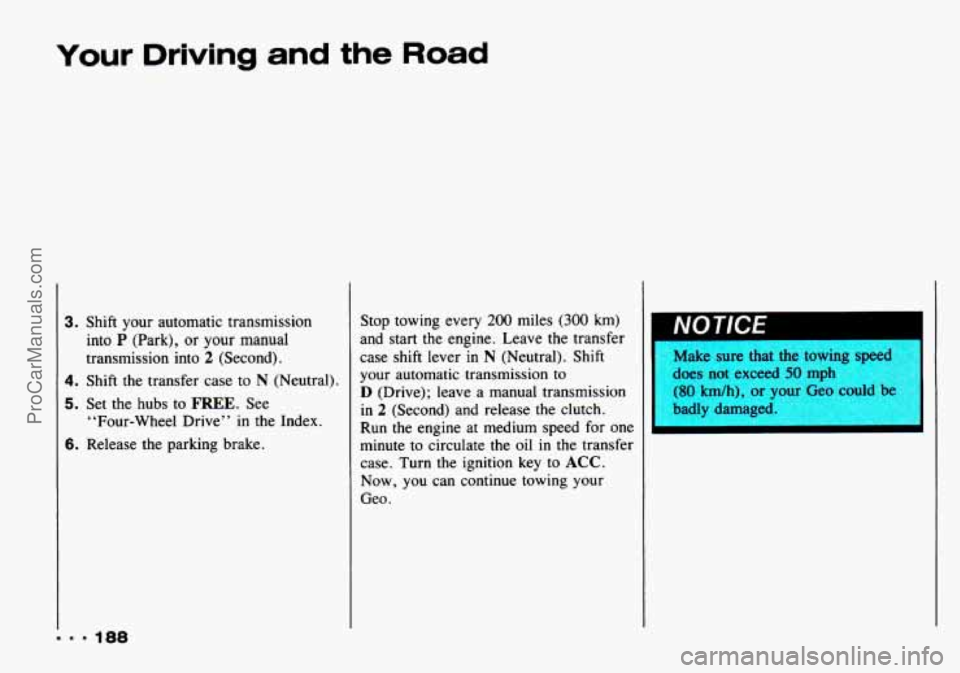
Your Driving and the Road
= - 9 188
3. Shift your automatic transmission
into
P (Park), or your manual
transmission into
2 (Second).
4. Shift the transfer case to N (Neutral).
5. Set the hubs to FREE. See
“Four-Wheel Drive” in the Index.
6. Release the parking brake. Stop towing every
200 miles (300 km)
and
start the engine. Leave the transfer
case shift lever in
N (Neutral). Shift
your automatic transmission
to
D (Drive); leave a manual transmission
in
2 (Second) and release the clutch.
Run the engine at medium speed for one
minute to circulate
the oil in the transfer
case. Turn
the ignition key to ACC.
Now, you can continue towing your
Geo
.
NU I Kt
Make sure that the towing speed
does not exceed
50 mph
(80 km/h), or your Geo could
badly damaged.
ProCarManuals.com
Page 195 of 339

3. Turn off the ignition on both
vehicles. Turn
off all lights that
aren’t needed, and radios. This will
avoid sparks and help save both
batteries. And
it could save your
radio!
f you leave your radio on, it
ould be badly damaged.
Thc
?pairs wouldn’i 2 cove--? by
our warrant.
4. Open the hoods and locate the
batteries.
CA UTiON
A An electric fan can start up
- even when the engine is not
running and
can injure you. Keep
hands, clothing and tools away from any underhood electric fan.
Find the positive
(+) and negative
(-) terminals on each battery. Using
a match near
a battery
can cause battery gas to
explode. People
have been hurt
doing this, and some have been
blinded. Use a flashlight if
you
need more light.
Be sure the battery has enough
water. You don’t need to add
water to the Delco Freedom*
battery installed
in every new GM
vehicle. But if a battery has filler
caps, be sure the right amount of
fluid is there. If it is low, add
water
to take care of that first. If
you don’t, explosive gas could be
present.
Battery fluid contains acid that can
burn you. Don’t get
it on you. If
you accidentally get
it in your eyes
or on your skin, flush the place
with water and get medical help
immediately.
ProCarManuals.com
Page 199 of 339
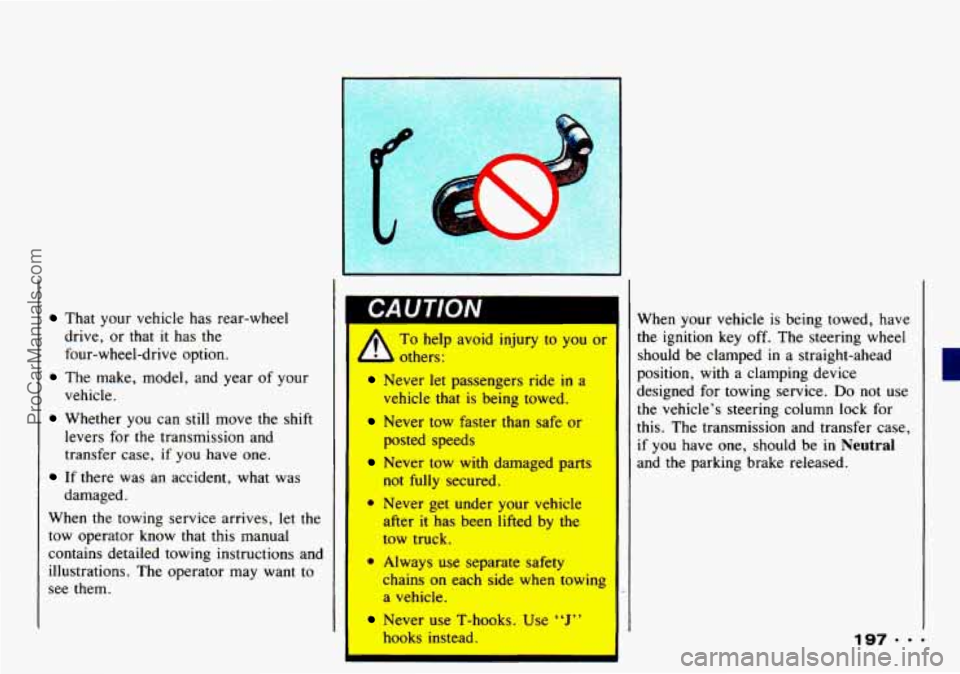
That your vehicle has rear-wheel
drive, or that
it has the
four-wheel-drive option.
vehicle.
The make, model, and year of your
Whether you can still move the shift
levers for the transmission and
transfer case,
if you have one.
If there was an accident, what was
damaged.
When the towing service arrives, let the
tow operator know that this manual
contains detailed towing instructions and
illustrations. The operator may want to
see them.
* T- help avoid injury to you or
Never let passengers ride in a
vehicle that is being towed.
Never tow faster than safe or
posted speeds
Never tow with damaged parts
not fully secured.
0 Never get under your vehicle
after it
has been lifted by the
tow truck.
chains on each side when towing
a vehicle.
hooks instead.
* Always use separate safety
Never use T-hooks. Use “J”
When your vehicle is being towed, have
the ignition key off. The steering wheel
should be clamped
in a straight-ahead
position, with
a clamping device
designed for towing service.
Do not use
the vehicle’s steering column lock for
this. The transmission and transfer case,
if you have one, should be in Neutral
and the parking brake released.
ProCarManuals.com
Page 276 of 339
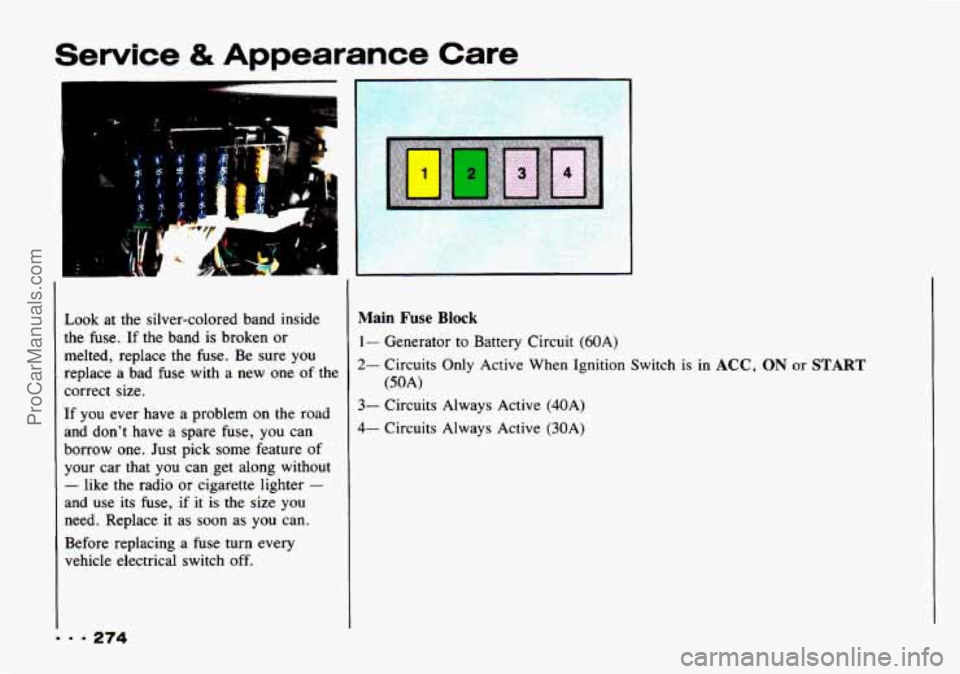
Service & Appearance Care
b. . /. , ,.
s Y
Look at the silver-colored band inside
the fuse.
If the band is broken or
melted, replace the fuse. Be sure you
replace a bad fuse with a new
one of the
correct size.
If you ever have a problem on the road
and don't have a spare fuse, you can
borrow one. Just pick some feature of
your car that
you can get along without
- like the radio or cigarette lighter -
and use its fuse, if it is the size you
need. Replace it as soon as you can.
Before replacing a fuse turn every
vehicle electrical switch off.
... 274
Main Fuse Block
1- Generator to Battery Circuit (60A)
2- Circuits Only Active When Ignition Switch is in ACC, ON or START
3- Circuits Always Active (40A)
4- Circuits Always Active (30A)
(50A)
ProCarManuals.com
Page 277 of 339

[ Instrument Panel Fuse Block
1 - Right Headlight (15A)
2- Left Headlight; High Beam Indicator Light (1 5A)
3-Taillights; Interior Light; Sidemarker Lights; Instrument Cluster Lights (15A)
4-Stop Lights; Horn (15A)
5- Hazard Lights (15A)
6-Door Lock (Option) (20A)
7- Lighter; Radio (20A)
8-Ignition System; Warning and Indicator Lights (15A)
9-Turn Signal Lights; Back-up Lights (15A)
10- Wiperwasher
(1 SA)
1 1 - Rear Defogger ( 15A)
12-Heater (25A) 13-Rear Wheel Anti-Lock Main Relay (20A)
14-Electronic Fuel Injection Main Relay (15A)
ProCarManuals.com
Page 330 of 339

Halogen Bulbs .................. 248
Halogen Headlight Bulb
Replacement
.................. 248
Hazard Warning Flashers
.......... 190
Haze. Driving in Fog. Mist and ..... 162
Head Restraints
................... 14
Headlights Halogen Bulb Replacement
....... 248
High/Low Beam
................ 70
Lever. Turn Signal/Lights
ControVHeadlight Beam
........ 67
Lights On Reminder
............. 69
Heater Controls ................. 102
Heating
........................ 103
Heating. Bi-Level
................ 103
High Beams
..................... 159
High/Low Beam. Headlight
......... 70
Highway Hypnosis
............... 168
Hill and Mountain Roads
.......... 169
Hill. Approaching a
.............. 146
Hills. Parking
on ................. 171
Hills. Driving on Off-Road
........ 145
Hitches (Trailer)
................. 180
Hood Release
................... 227
Hook-Ups. Front Towing
.......... 198
Hook-Ups. Rear Towing .......... 199
Hooks. Recovery
................ 2 18
Horn ........................... 67 Hubs. Free-Wheeling
.............. 58
Automatic
..................... 59
Manual
........................ 59
Hydroplaning
................... 16.1
Hypnosis. Highway .............. 168
Ice. Driving on Snow or .......... 174
Identification
Engine
....................... 272
Label. Service Parts
............ 272
Number. Vehicle
............... 272
Ignition Switch
................... 48
Incline. Driving across an
......... 152
Incline. Stalling on an
............. 154
Indicators. Warning Lights. Gages and
..................... 82
Inflation
- Tire Pressure .......... 254
Inspections. Periodic Maintenance
. . 303
Instrument Panel And Clusters
................... 80
Bins .......................... 75
Cleaning the Top of the
.......... 266
Fuse Block
.................... 275
Interior Lights
.................... 7 1
Jump Starting .................. 19 1
Keys ................ .... 44
Label. Certification
.............. 252
Label. Tire-Loading Information
.... 252 Lamp. Malfunction Indicator
. . ... 85
Lane Change Indicator. Turn
Signal and
..................... 68
Lap-Shoulder Belt (Safety Belt)
...... 24
Leather Cleaning
................ 265
Leaving the Freeway
............. 165
Leaving Your Vehicle with the Engine Running
................. 62
Levers Controls (Comfort Control System)
.................... 102
Turn SignaULights ControUHeadlight Beam
........ 67
Windshield Wiper/Washer
........ 72
Lighter. Cigarette
................. 77
Lights Brake System Warning
........... 84
Charging System
................ 85
Check Engine
.................. 85
Dome ......................... 71
Engine Oil Pressure
............. 85
Interior ........................ 71
Malfunction Indicator
............ 85
Oil Pressure. ................... 86
On Reminder ................... 69
Operation of ................... 69
Safety Belt Reminder ............ 23
Traffic
....................... 120
Warning. Gages and Indicators
.... 82
9 328
ProCarManuals.com